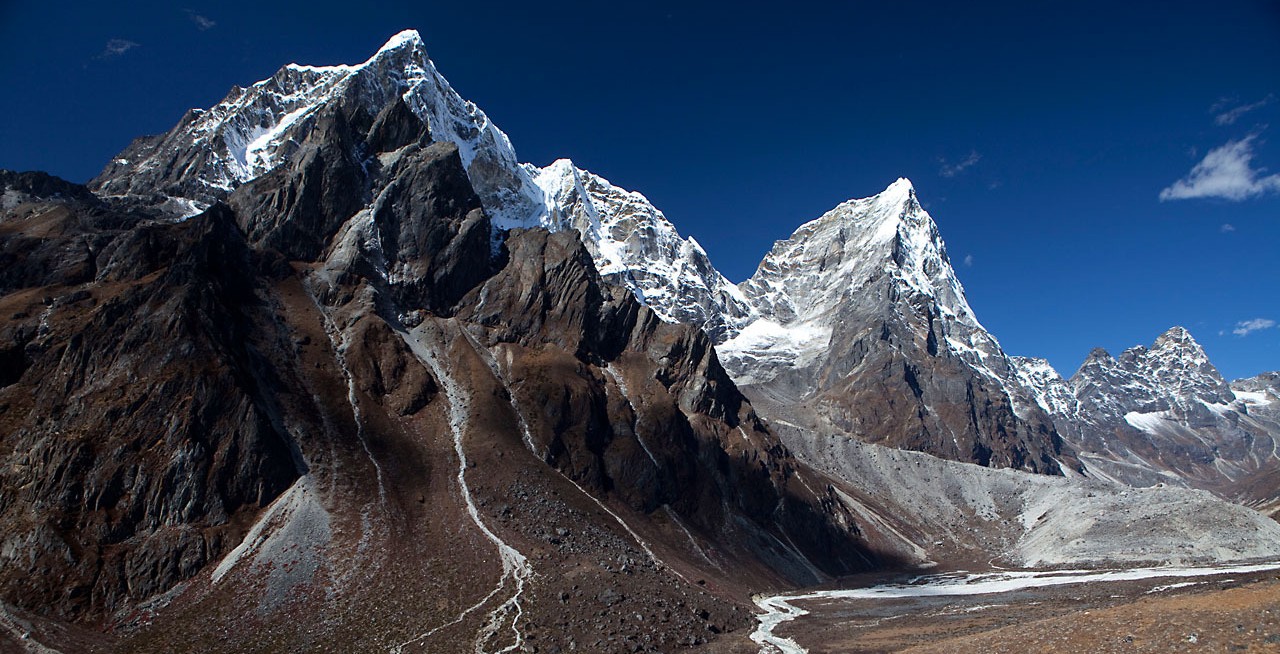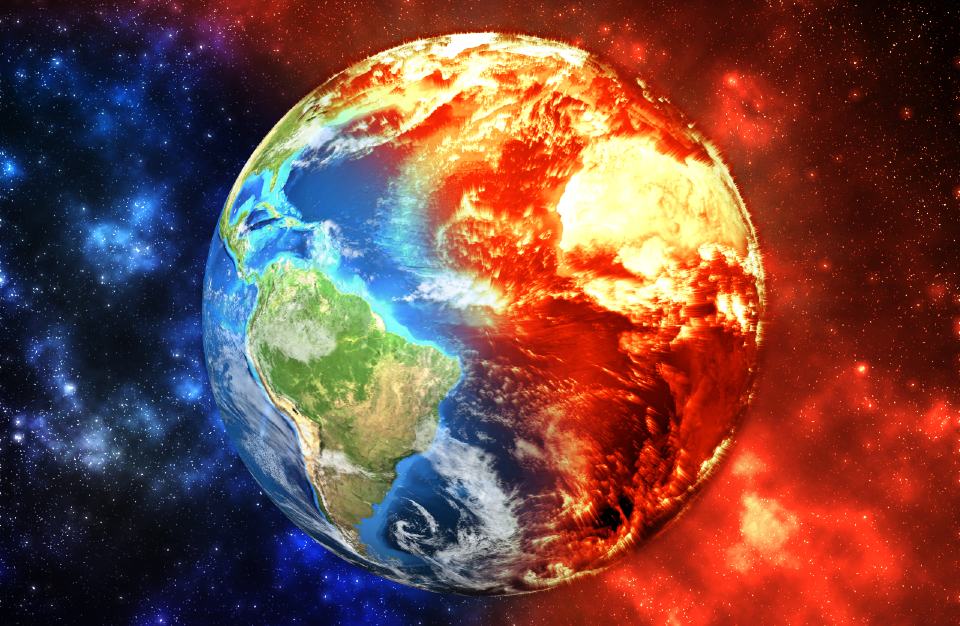Climate Change Fuelling Cyclone Biparjoy, Monsoon 2023 to see subdued onset
Cyclone Biparjoy has seen intensification even faster as it covered the journey from a cyclonic circulation (June 5) to a Severe Cyclonic storm in less than 48 hours (June 7).
By Editorial Team / Jun 7, 2023
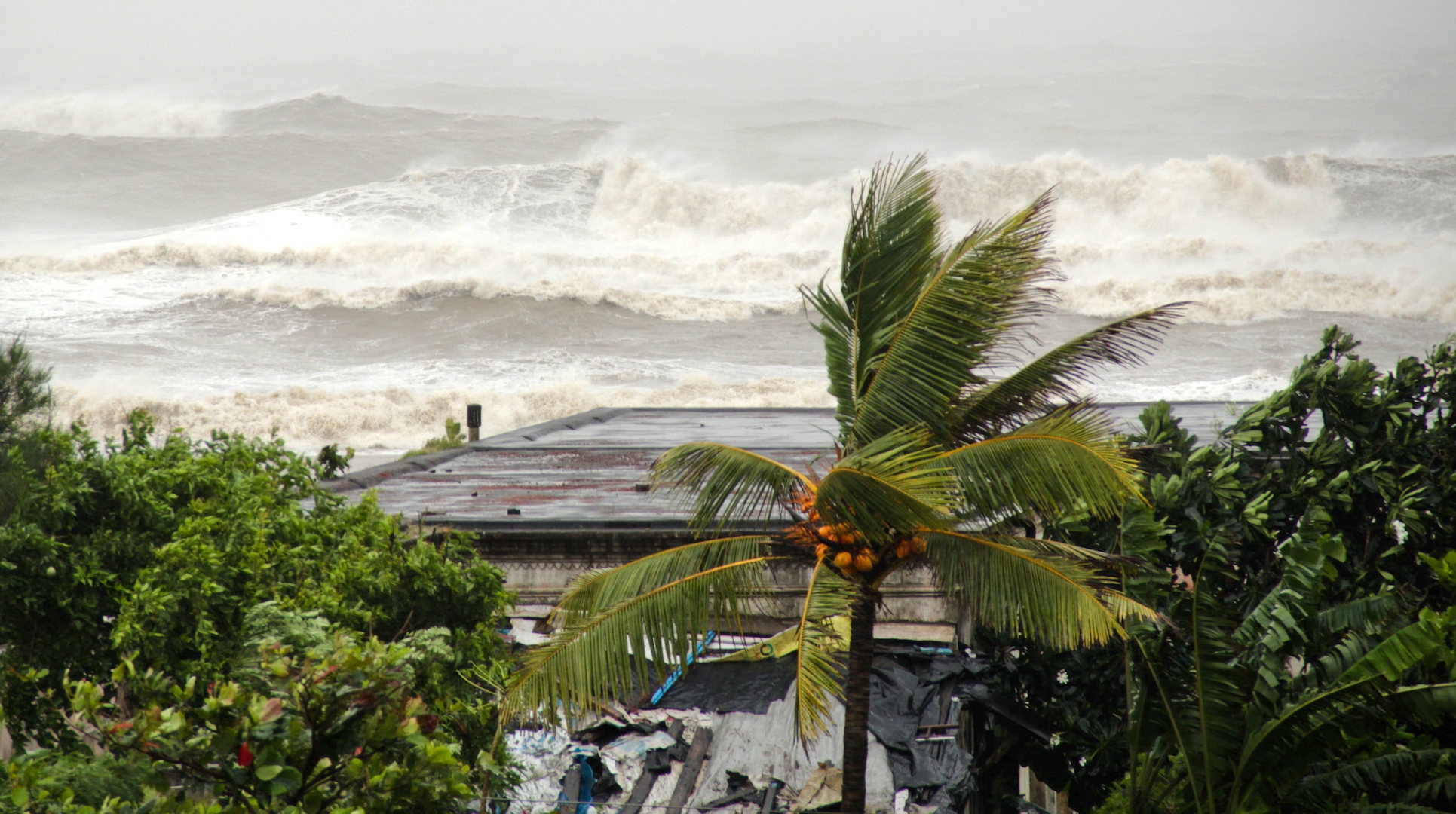
Image Credit: LifeGate
The wait for Southwest Monsoon 2023 will be a little longer for India, with a cyclonic storm Biparjoy developing in the Arabian Sea. The weather system is presently sustaining the strength of a very severe cyclone. According to meteorologists, atmospheric conditions and cloud mass are indicating that the system is likely to sustain the strength of a very severe cyclone till June 12.
According to the country’s nodal agency, India Meteorology Department (IMD), the system is likely to be more organized and may intensify up to a very severe cyclonic storm by June 9.
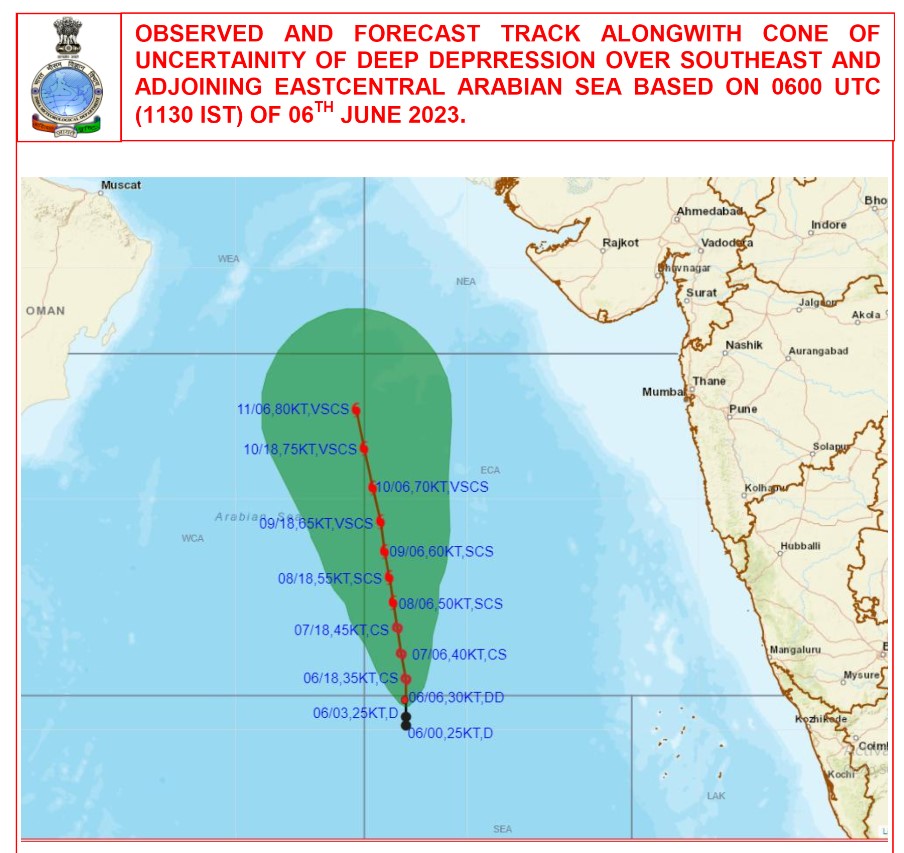
Image Credit: IMD
“Weather conditions are very ripe for the system to continue to gain more strength. With long sea travel ahead, Sea Surface Temperatures (SSTs) are very warm, infusing more heat and moisture into the atmosphere. This would help the system sustain its strength for a longer period,” said GP Sharma, President- Meteorology and Climate Change, Skymet Weather.
“The oceans have become warmer already on account of climate change. In fact, recent study shows that the Arabian Sea has warmed up by almost 1.2 degree Celsius since March, thus conditions are very much favourable for the rapid intensification of the system so it has potential to sustain the strength for a longer period,” said Dr Raghu Murtugudde, Professor, department of atmospheric and oceanic science, University of Maryland and IIT Bombay.
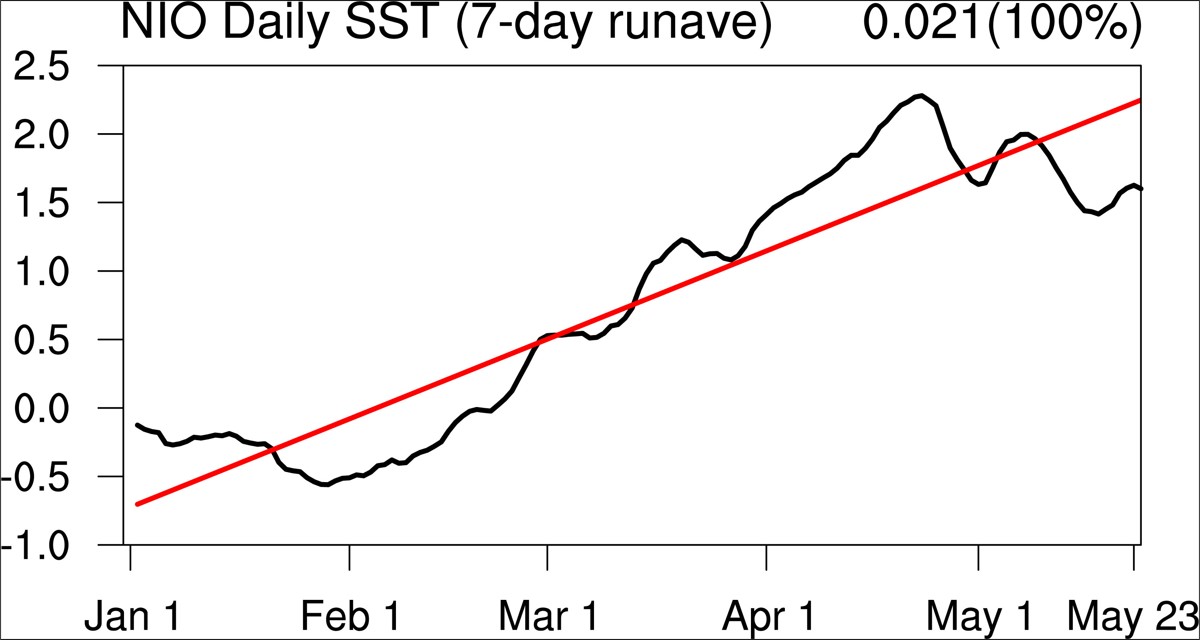
Image Credit: Dr Raghu Murtugudde and Baosheng Li
According to the report, Changing status of tropical cyclones in the north Indian Ocean, the frequency, duration, and intensity of cyclones in the Arabian Sea have increased significantly. The intensity of cyclones also has increased in the Arabian Sea, by about 20% (post-monsoon) to 40% (pre-monsoon). There has been a 52% increase in the number of cyclones in the Arabian Sea, while very severe cyclones have increased by 150%.

Further, there has been an 80% increase in the total duration of cyclones in the Arabian Sea during the last two decades. The duration of very severe cyclones has increased by 260%.
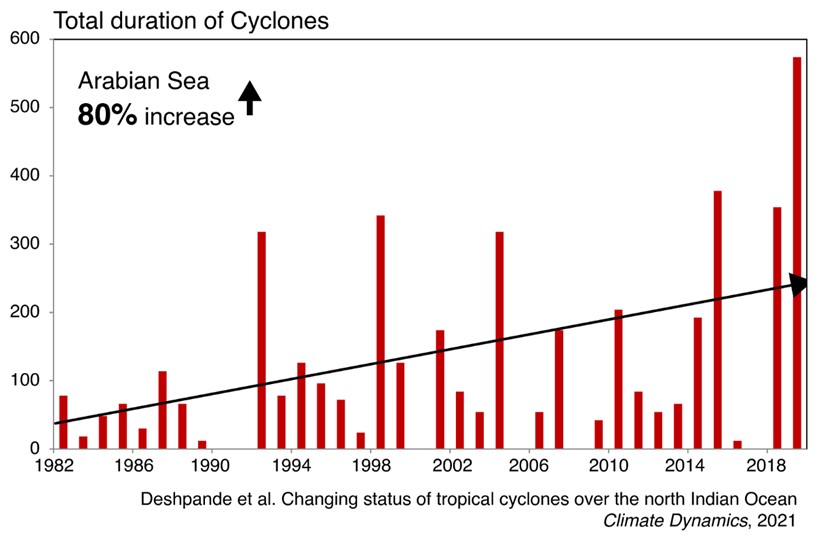
Cyclone Biporjoy and Monsoon 2023
IMD had predicted the onset of the Monsoon on June 4 with an error margin of +/- 4%. The onset of the Monsoon over the Indian landmass of Kerala is declared after meeting the three meteorological criteria. Rainfall over 60% of the given 14 stations in Kerala should be more than 2.5 mm for two consecutive days. Secondly, the depth of westerly winds along with the value of Outgoing Longwave Radiation (OLR), which is the energy emitted by the Earth's surface, oceans, and atmosphere into space should be below a certain value in the given area.
According to IMD, the weather conditions are gradually becoming favourable for the onset of the Monsoon. All the required features are getting aligned. However, with cyclone Biparjoy brewing in the Arabian Sea, meteorologists have already warned against a thumping onset over Kerala.
“Looking at the location of the likely cyclonic storm, there are chances that Monsoon might make the onset around 8-9 June but it will not be a loud or strong one. Clouds and rainfall are the visible manifestation of the arrival of the Monsoon, which will be satisfied during the process of intensification of the cyclone. Hence, the onset will be there but a subdued one. However, it would definitely be detrimental to the progress of the Monsoon and the strengthening of the Monsoon stream,” said G P Sharma.
“An exceptionally warm Arabian Sea, a weak monsoon onset, and favourable Madden Julian Oscillation (MJO) conditions in the Indian Ocean are favouring this cyclone. With this, it would not be the case of classic Monsoon onset, satisfying all the given criteria. We would have scattered rains along the West Coast strip but no inland penetration and widespread rains,” said Dr Roxy Mathew Koll, Climate Scientist at the Indian Institute of Tropical Meteorology and Lead IPCC Author.
Dr Koll further added, “We are presently witnessing weak Monsoon winds, and under such circumstances, a cyclone develops favourably in the Arabian Sea. If the southwest Monsoon current is strong, winds blow in two directions – southwest in lower levels and northeast in upper levels. This would not allow the weather system to rise vertically and form into a cyclonic storm. However, when the Monsoon is weak, the cyclone can develop vertically as it can cut through the winds and move upwards.”
Role of Climate Change
The increase in cyclone activity in the Arabian Sea is tightly linked to rising ocean temperatures and increased availability of moisture under global warming. The most recent example is Cyclone Mocha, which went up to the intensity of a very severe cyclone.
Cyclone Biparjoy has seen intensification even faster as it covered the journey from a cyclonic circulation (June 5) to a Severe Cyclonic storm in less than 48 hours (June 7).
According to experts, there has been an increase in the frequency of cyclones developing near the onset of Monsoon, for instance, Cyclone Tauktae. The rise in cyclogenesis in the Indian Ocean has been the result of weakened Monsoon circulation triggered by climate change.
“Sea Surface Temperatures (SST) usually remain high during this time of the year. However, presently they are 2-3 degrees higher than the usual warmer temperatures. This means there is more heat and moisture in the atmosphere, which helps cyclonic storms to maintain their strength for a longer period. The threshold value for the formation of a cyclone is 26 degree Celsius, but at present SSTs are in the range of 30-32 degrees Celsius. This rise can be attributed to a rise in the ocean heat due to climate change,” said Roxy Koll.
The accumulated cyclone energy in the Arabian Sea has almost tripled. Accumulated cyclone energy is a measure of the total wind energy during a cyclone’s lifetime. The translation speed of cyclones (the speed at which cyclones move) has decreased in the Arabian Sea. This means that cyclones are now moving slowly, which means increasing the threat quotient. As the cyclone becomes more marked, it moves slowly over the sea. And, more sea travel means more moisture feed for it to maintain its strength.
According to a report, Assessment of Climate Change over the Indian Region, most models project a higher SST warming in the Arabian Sea than the Bay of Bengal. The observed surface warming over the Indian Ocean has been linked to natural and anthropogenic (human induced) causes. Climate model simulations show that over 90% of the Sea Surface Temperature trend since the 1950s is very likely due to increased anthropogenic emissions, while the remaining is due to internal variability. Among the anthropogenic causes, change in radiative forcing due to the increased greenhouse gas concentrations is the major factor. Radiative forcing is a measure of the difference between incoming solar radiation and outgoing terrestrial radiation in the Earth-atmosphere system. The intensity of tropical cyclones (TC) is closely linked to ocean Sea Surface Temperatures (SST) and heat content, with regional differences in their relationships. With continued global warming, the activity of very severe cyclonic storms (VSCS) over the North Indian Ocean (NIO) is projected to increase further during the twenty-first century.
According to IPCC report on Ocean, Cryosphere and Sea Level Change, at the ocean surface, temperature has, on average, increased by 0.88 [0.68 to 1.01] °C between 1850–1900 and 2011–2020, with 0.60 [0.44 to 0.74] °C of this warming having occurred since 1980. The ocean surface temperature is projected to increase between 1995 to 2014 and 2081 to 2100 on average by 0.86 [0.43 to 1.47, likely range] °C in SSP1-2.6 and by 2.89 [2.01 to 4.07, likely range] °C in SSP5-8.5. Since the 1950s, the fastest surface warming has occurred in the Indian Ocean and in the western boundary current. The intensity of severe tropical cyclones would increase in a warmer climate.
